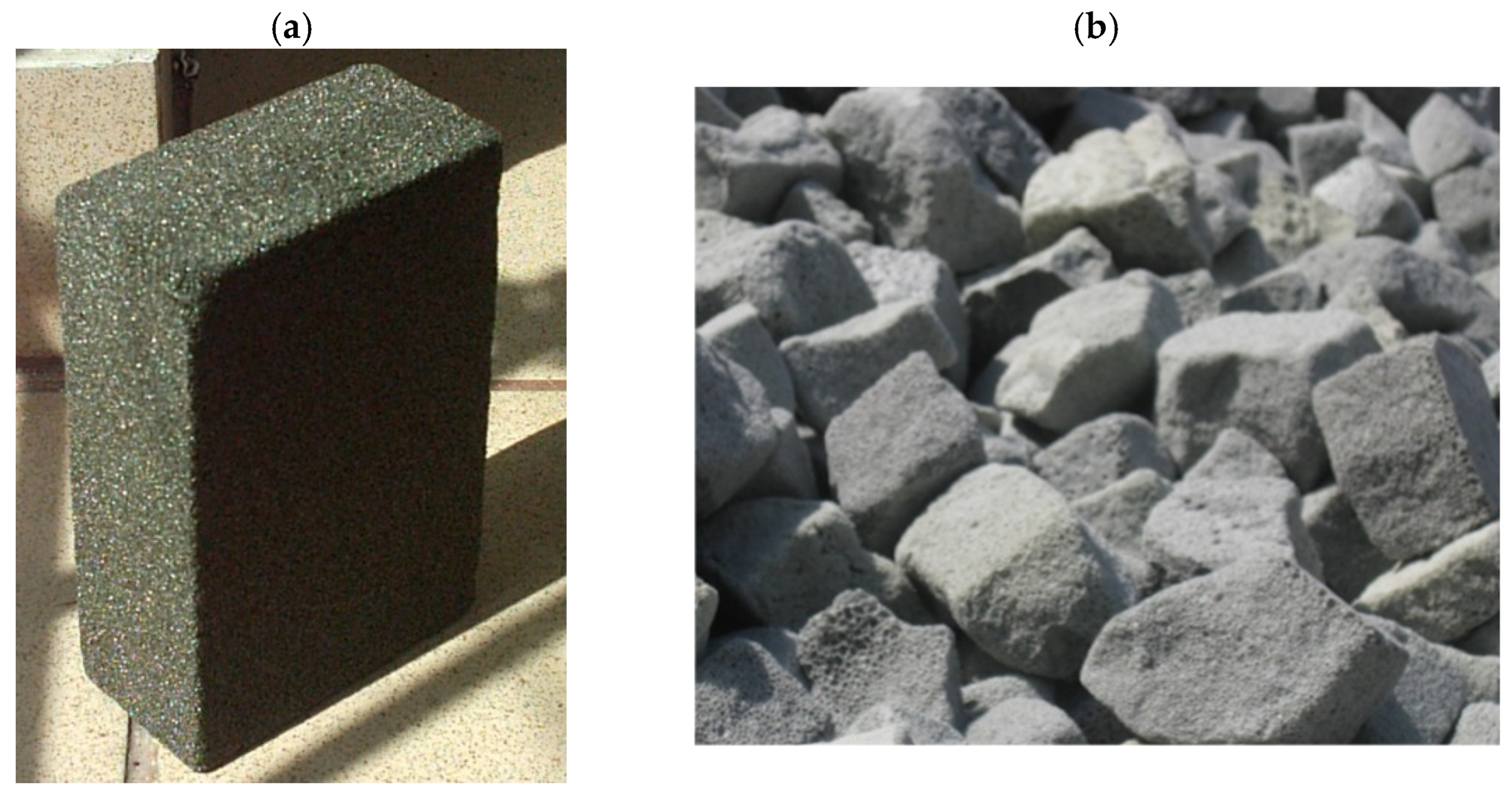Concept of Adapting the Liquidated Underground Mine Workings into High-Temperature Sand Thermal Energy Storage
Abstract
1. Introduction
- Seasonal thermal storage
- high heat capacity;
- high energy stability (stored thermal energy);
- high chemical stability (in the case of water);
- low operating costs;
- environmental neutrality.
- capacity, which determines the amount of energy that can be stored. This depends on the storage method (technology), the medium used, and the size of the system;
- storage unit power, i.e., quantity determining how quickly the storage unit can be charged or discharged;
- system efficiency, i.e., the ratio of energy supplied to the user to the energy needed to charge the warehouse—this value takes into account energy losses during storage as well as losses during charging and discharging the battery;
- storage period;
- charging and discharging time;
- costs related to efficiency—this value depends on capital expenditure and operational life of the system.
- High heat capacity compared to, e.g., water; sand can be heated to temperatures well above the boiling point of water. Sand-based heat storage facilities can store several times more energy than water storage facilities of the same volume. This saves space and facilitates versatile use in many industrial processes;
- Fuel versatility—heat storage is not sensitive to the size of sand grains.
2. Concept of Sand Heat Storage in the Closed Mine Workings
2.1. Assumptions for a New Solution with the Technical Data
- Variant 1—heat storage with a sand container:
- ○
- assumed heat storage volume: 100 m3;
- ○
- assumed heat storage power: 100 kW;
- ○
- assumed heat storage heat capacity (at temp. 500 °C): 11.37 MWh.
- Variant 2—heat storage in a blind roadway:
- ○
- assumed heat storage volume: 1070 m3;
- ○
- assumed heat storage power depending on fluid flowrate >100 kW;
- ○
- assumed heat storage heat capacity (at temp. 500 °C): 100 MWh.
- Variant 3—heat storage demonstrator:
- ○
- assumed heat storage volume: 25 m3;
- ○
- assumed heat storage power: 50 kW;
- ○
- assumed heat storage heat capacity (at temp. 500 °C): 2.27 MWh.
2.2. Selection of Insulating Materials
2.3. Method for Fixation of Thermal Insulation
2.4. Installation of Insulating Materials in the Suggested Energy Storage Variants
- Variant 1. Concept of the heat storage of volume 100 m3
- Variant 2. Concept of heat storage in a mine blind roadway
3. Proposal of Solutions for Heat Storage Systems Using High-Temperature Sand Storages
- VARIANT 1—using the proper containers in underground mine workings.
- VARIANT 2—construction of heat storage in roadways of the liquidated mines
- VARIANT 3—demonstrator
- heating residential estates, e.g., by connecting to the municipal heating system;
- heating private estates—single-family houses;
- heating public places such as nurseries, kindergartens, schools, offices, hospitals, etc.;
- heating of domestic hot water;
- heating the road infrastructure—instead of snow removal and chemical agents used on roads when they are icy, by turning the heating on, the snow and ice will melt (aspect of financial savings for the city/district and pro-ecological aspect—no chemicals, no emissions during the production of brines, no emissions during spreading salt by snow plows).
4. Discussion
5. Conclusions
- One of the directions of the research work will be the optimization of the thickness of the insulation layer and the differentiation in its thickness and the variability in materials in relation to the height in order to optimize costs while maintaining the required effectiveness.
- Another aspect will be the performance of virtual prototyping tasks. As part of this work, a numerical model will be developed, which will be used to perform numerical analyses using CFD methods. This work will aim to verify and optimize the operation of heat exchangers, the effectiveness of the insulation layer, and the selection of the target temperature of the heat storage.
- Another direction of the application of numerical analyses will be to optimize the method of laying out the coils in the heat storage. This is important from the point of view of the even level of heating of the sand in the warehouse and avoiding the occurrence of “dead zones” in which it is difficult to achieve the assumed temperature or in which there may be a problem with heat reception.
- Another important issue is the possibility of considering the use of alternative media circulating in coils in the heat warehouse.
- Before the final implementation, it is necessary to build a prototype that takes into account the above-mentioned problematic aspects both in a purely technical and organizational sense. Further activities will be planned towards the construction of a demonstrator in conditions close to real ones.
Author Contributions
Funding
Data Availability Statement
Conflicts of Interest
References
- Website. Available online: https://web.archive.org/web/20240226074456/www.iftechnology.com/aquifer-thermal-energy-storage/ (accessed on 10 July 2024).
- Conference Presentation. Available online: https://docplayer.pl/5441174-Magazynowanie-energii-na-potrzeby-ogrzewania-chlodzenia-przyklady-rozwiazan.html (accessed on 12 July 2024).
- Janas, S. The concept of a household low-speed kinetic energy storage. Min. Mach. 2023, 41, 37–47. [Google Scholar]
- Malec, M.; Stańczak, L.; Ricketts, B. Just transition of post mining areas—Technical, economic, environmental and social aspects. Min. Mach. 2023, 41, 11–24. [Google Scholar]
- Website. Available online: https://www.macobo-stabo.be/diensten/gebouwtechnieken/show/85 (accessed on 12 July 2024).
- Ermiş, K.; Findik, F. Thermal energy storage. Sustain. Eng. Innov. 2020, 2, 66–88. [Google Scholar] [CrossRef]
- Website. Available online: https://www.rynekelektryczny.pl/moc-zainstalowana-fotowoltaiki-w-polsce/ (accessed on 14 March 2025).
- Website. Available online: https://ieo.pl/aktualnosci/1684-fotowoltaika-w-polsce-w-2023-i-2024-nowe-moce-i-nowe-wyzwania (accessed on 14 March 2025).
- Website. Available online: https://www.oze.pl/blog/30-gw-w-polskiej-fotowoltaice-do-2026-roku-to-mozliwe (accessed on 14 March 2025).
- Pijarski, P.; Saigustia, C.; Kacejko, P.; Bena, L.; Belowski, A. The impact of renewable energy sources on the overload of high voltage lines—Power flow tracking versus direct current method. Arch. Electr. Eng. 2024, 73, 519–541. [Google Scholar] [CrossRef]
- Website. Available online: https://zielonagospodarka.pl/jak-wyglada-rynek-fotowoltaiki-w-polsce-w-2024-roku-17097 (accessed on 14 March 2025).
- Chavan, S.; Rudrapati, R.; Manickam, S. A comprehensive review on current advances of thermal energy storage and its applications. Alex. Eng. J. 2022, 61, 5455–5463. [Google Scholar] [CrossRef]
- White, M.T.; Sayma, A.I. A new method to identify the optimal temperature of latent-heat thermal-energy storage systems for power generation from waste heat. Int. J. Heat Mass Transf. 2020, 149, 119111. [Google Scholar] [CrossRef]
- Sarbu, I.; Sebarchievici, C. Solar Heating and Cooling: Fundamentals, Experiments and Applications; Oxford Elselvier: Oxford, UK, 2016; ISBN 978-0-12-811662-3. [Google Scholar]
- Dinçer, I.; Rosen, M.A. Thermal Energy Storage Systems and Applications; John Wiley & Sons: Toronto, ON, Canada, 2011; ISBN 9781119713166. [Google Scholar]
- Heat Storage—Types of Storage. Heat Storage is a Process That Poses Special Challenges to Physicists, Chemists and Designers. Available online: https://www.cire.pl/artykuly/materialy-problemowe/119630-magazynowanie-ciepla-rodzaje-magazynow (accessed on 12 July 2024).
- Million Cubic Meter 90GWh Thermal Storage Project in Finland Could Begin Construction Next Year. Available online: https://www.energy-storage.news/million-cubic-metre-90gwh-thermal-storage-project-in-finland-could-begin-construction-next-year (accessed on 12 July 2024).
- Mania, T.; Kawa, J. Inżynieria Instalacji Magazynowania Energii Ciepła; Mroziński, A., Ed.; Grafpol Agnieszka Blicharz-Krupińska: Bydgoszcz, Poland, 2016. [Google Scholar]
- Jastrzębski, P.; Saługa, P.W. Innowacyjne metody magazynowania ciepła. Zesz. Naukowe. Inst. Gospod. Surowcami Miner. Energią 2018, 105, 225–232. [Google Scholar]
- World’s First Sand Battery the Answer to Energy Challenges? Available online: https://dzienniknaukowy.pl/nowe-technologie/pierwsza-na-swiecie-bateria-piaskowa-odpowiedzia-na-wyzwania-energetyczne (accessed on 12 July 2024).
- Alva, G.; Lin, Y.; Fang, G. An overview of thermal energy storage systems. Energy 2018, 144, 341–378. [Google Scholar]
- Ochs, F.; Heidemann, W.; Müller-Steinhagen, H. Langzeit-Wärmespeicher für Solare Unterstützte Nahwärmesysteme; 2. Internationale Speicherkonferenz Erneuerbare Energien-IRES II: Bonn, Germany, 2007. [Google Scholar]
- Ochs, F.; Müller-Steinhagen, H. Abschlussbericht zum Vorhaben Weiterentwicklung der Erdbecken-Wärmespeichertechnologie FKZ 0329607 E. Institut für Thermodynamik und Wärmetechnik (ITW), Universität Stuttgart, Stuttgart: S.n. 2008. Available online: https://www.igte.uni-stuttgart.de/veroeffentlichungen/publikationen/publikationen_08-05.pdf (accessed on 15 July 2024).
- Website. Available online: https://gazetawroclawska.pl/magazyn-ciepla-w-piasku-w-soli-dlaczego-nie/ar/c15-16885841 (accessed on 15 July 2024).
- Kalidasan, B.; Pandey, A.K.; Shahabuddin, S.; Samykano, M.; Thirugnanasambandam, M.; Saidur, R. Phase change materials integrated solar thermal energy systems: Global trends and current practices in experimental approaches. J. Energy Storage 2020, 27, 101118. [Google Scholar] [CrossRef]
- Sand Battery. Available online: https://polarnightenergy.fi/sand-battery (accessed on 15 July 2024).
- The World’s First “Sand Battery” Goes Live. Available online: https://wired.me/science/worlds-first-sand-battery-finland (accessed on 15 July 2024).
- NREL Options a Modular, Cost-Effective, Build-Anywhere Particle Thermal Energy Storage Technology. Available online: https://www.nrel.gov/news/program/2021/nrel-options-a-modular-cost-effective-build-anywhere-particle-thermal-energy-storage-technology.html (accessed on 15 July 2024).
- Mangold, D. Erfahrungen und Ergebnisse aus der Umsetzung der Bundesforschungsprogramme Solarthermie-2000 und Solarthermie2000plus Input zum EU-Vorhaben Solarge (Solarthermische Großanlagen); Target GmbH: Hannover, Germany, 2006. [Google Scholar]
- Kaczmarczyk, K.; Dobrzaniecki, P. Energy storage using compressed air. Min. Mach. 2023, 41, 25–36. [Google Scholar]
- Finns “Invented the Sand Battery,” or TES Heat Storage, Which Has Been Known for 50 Years. Available online: https://itbiznes.pl/felieton/finowie-wynalezli-piaskowa-baterie-tes/ (accessed on 15 July 2024).
- MAGALDI—Quartz Sand an Energy Store. Available online: https://magazynfotowoltaika.pl/magaldi-piasek-kwarcowy-magazynem-energii/ (accessed on 15 July 2024).
- Sarbu, I.; Sebarchievici, C.A. Comprehensive Review of Thermal Energy Storage. Sustainability 2018, 10, 191. [Google Scholar] [CrossRef]
- Using Ice and Sand for Energy Storage. Available online: https://e-magazyny.pl/magazyny-energii/wykorzystanie-lodu-i-piasku-do-magazynowania-energii/ (accessed on 15 July 2024).
- Sand, Ice and Supercritical CO2: Innovative Long-Duration System Offers ‘Cheapest Energy Storage Yet’. Available online: https://www.rechargenews.com/energy-transition/sand-ice-and-supercritical-co2-innovative-long-duration-system-offers-cheapest-energy-storage-yet-/2-1-1011163 (accessed on 15 July 2024).
- Hua, W.; Lv, X.; Zhang, X.; Ji, Z.; Zhu, J. Research progress of seasonal thermal energy storage technology based on supercooled phase change materials. J. Energy Storage 2023, 67, 107378. [Google Scholar]
- What Are Sand Batteries and Can They Solve the Sustainable Energy Crisis? Available online: https://www.azom.com/article.aspx?ArticleID=21871 (accessed on 15 July 2024).
- Surplus from RES Will Go into the Sand? New Idea for Energy Storage! Available online: https://globenergia.pl/nadwyzki-z-oze-trafia-do-piachu-nowy-pomysl-na-magazynowanie-energii (accessed on 15 July 2024).
- Foam Glass. Available online: https://commons.wikimedia.org/wiki/File:Foamed_glass_block.jpg (accessed on 15 July 2024).
- Granulated Foam Glass. Available online: https://pl.wikipedia.org/wiki/Plik:Szk%C5%82o_spienione_(piankowe).png (accessed on 15 July 2024).
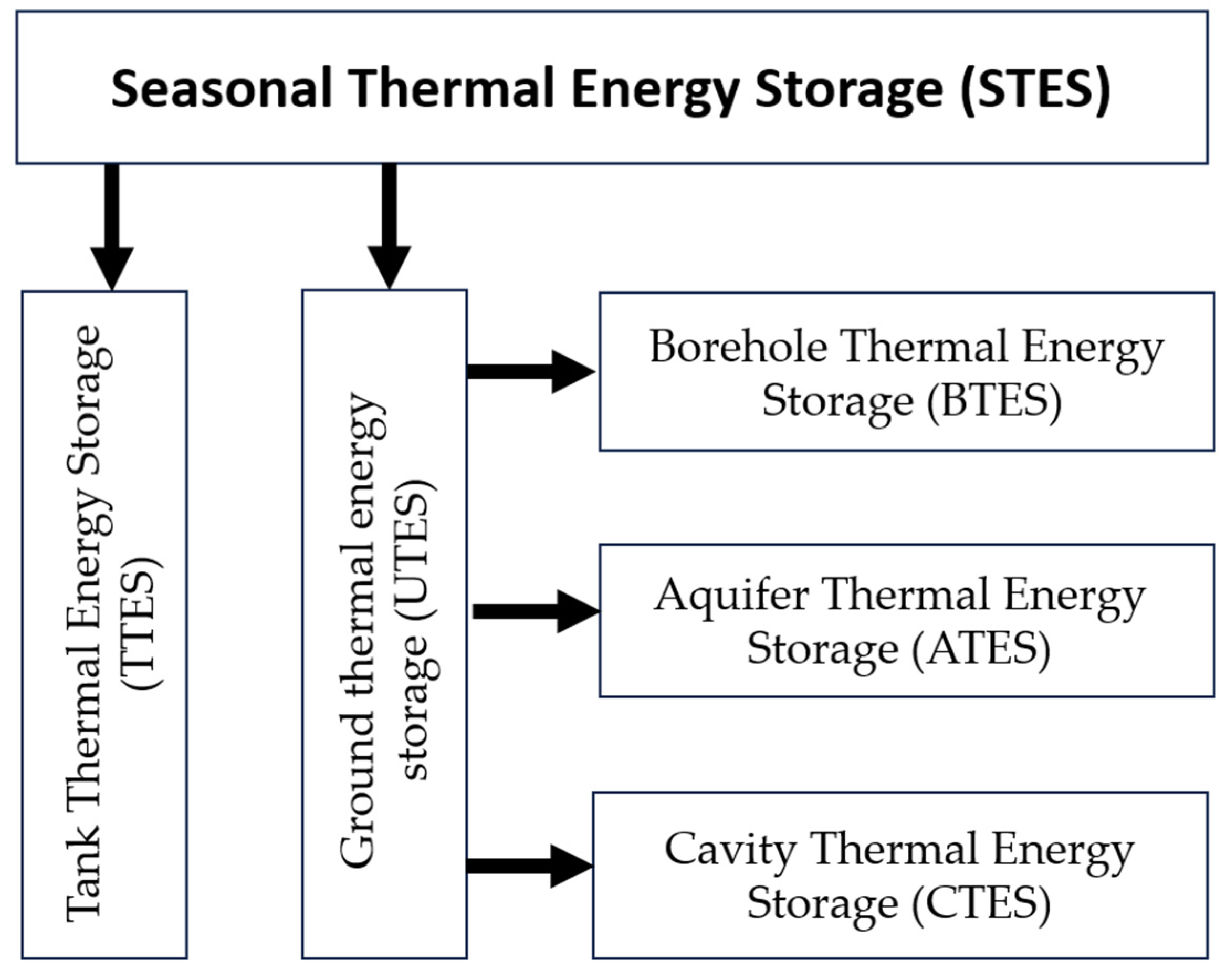
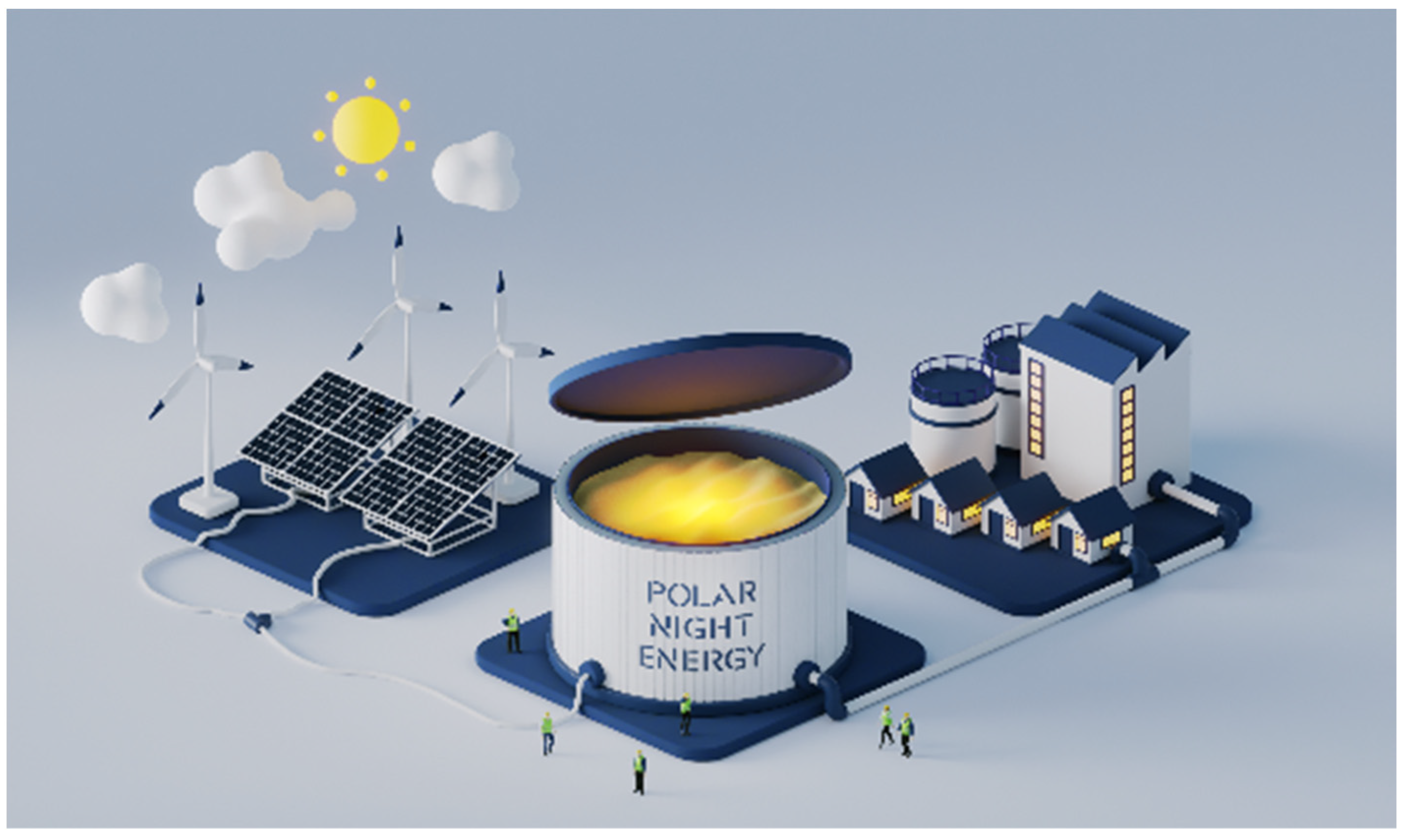
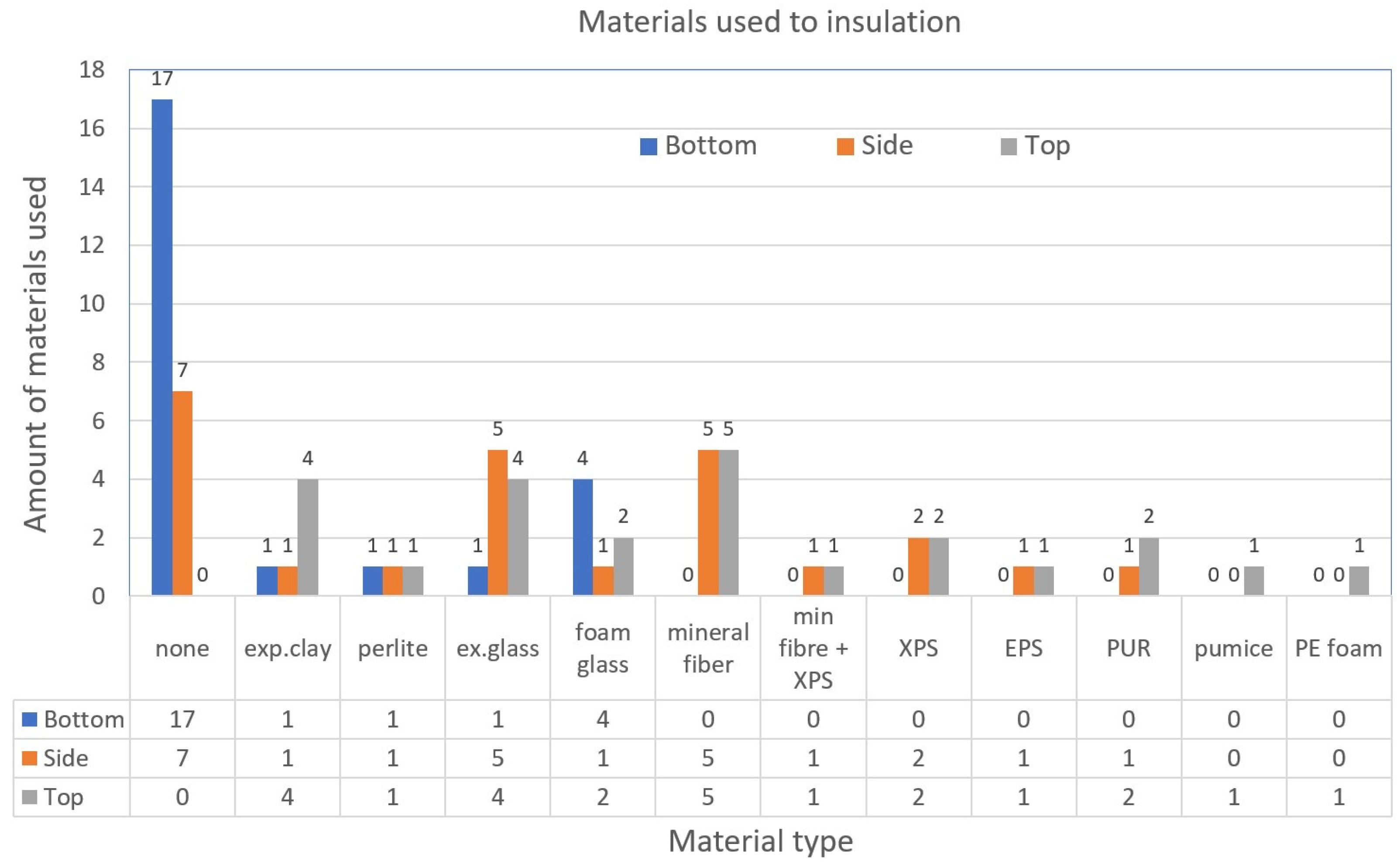
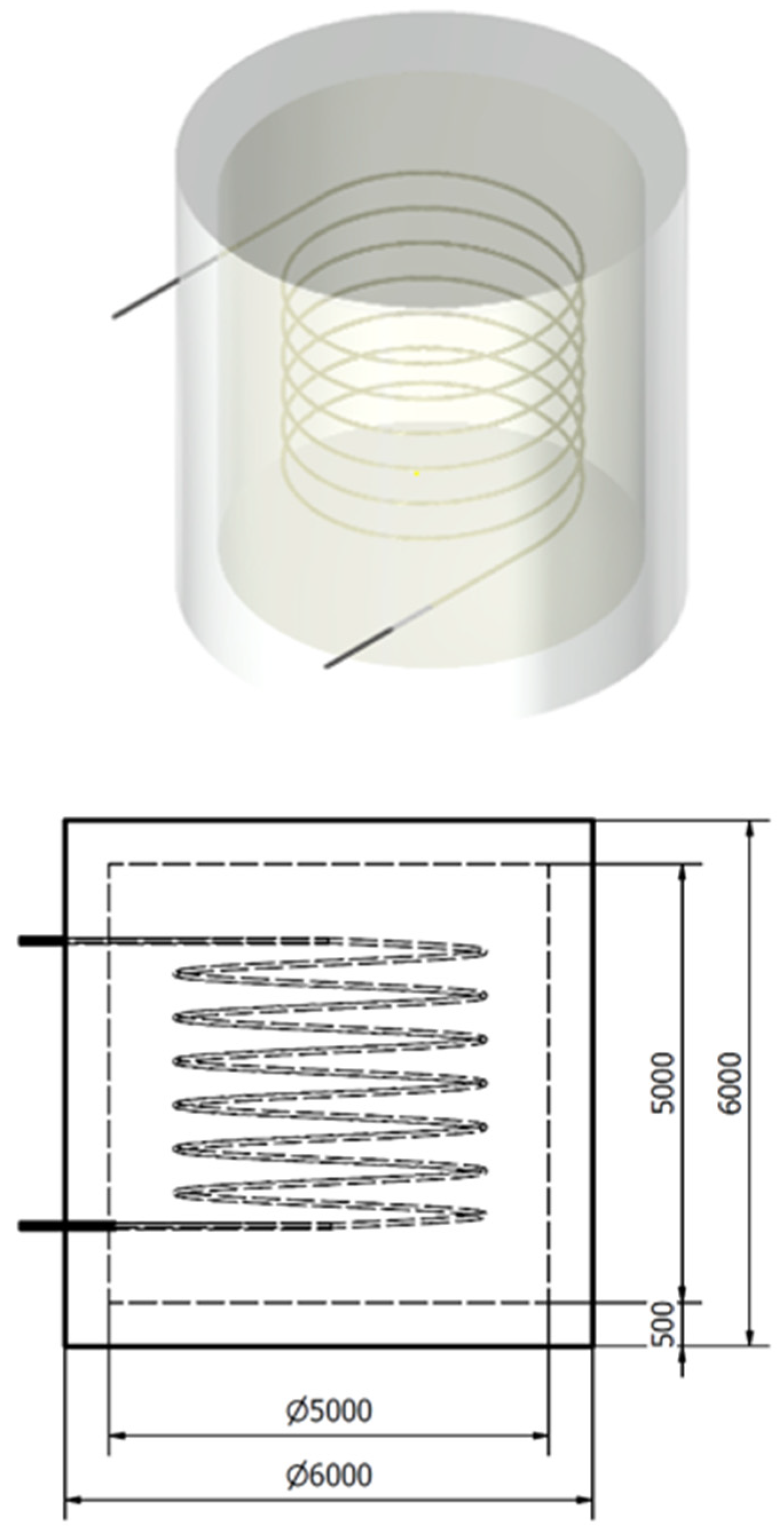
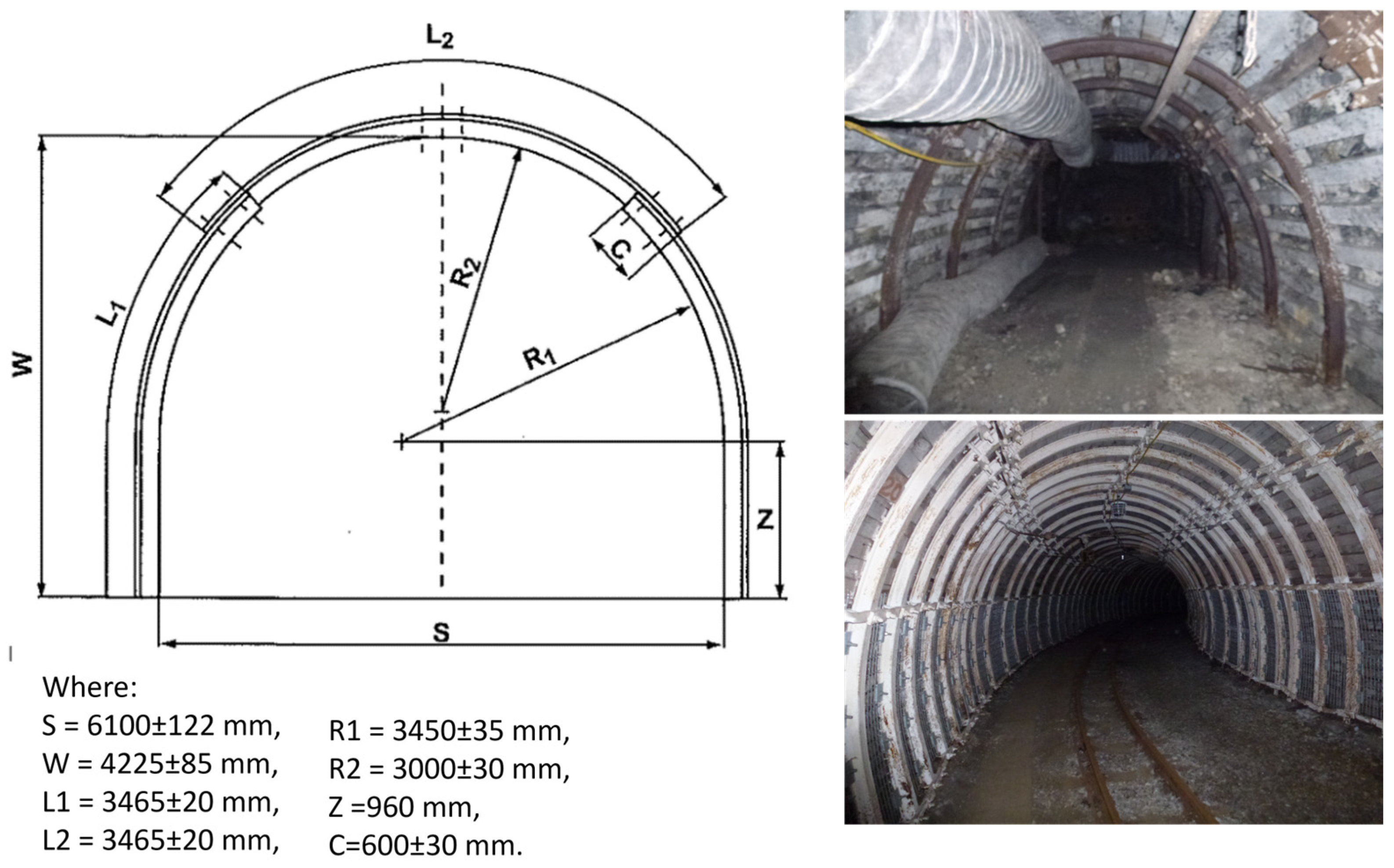

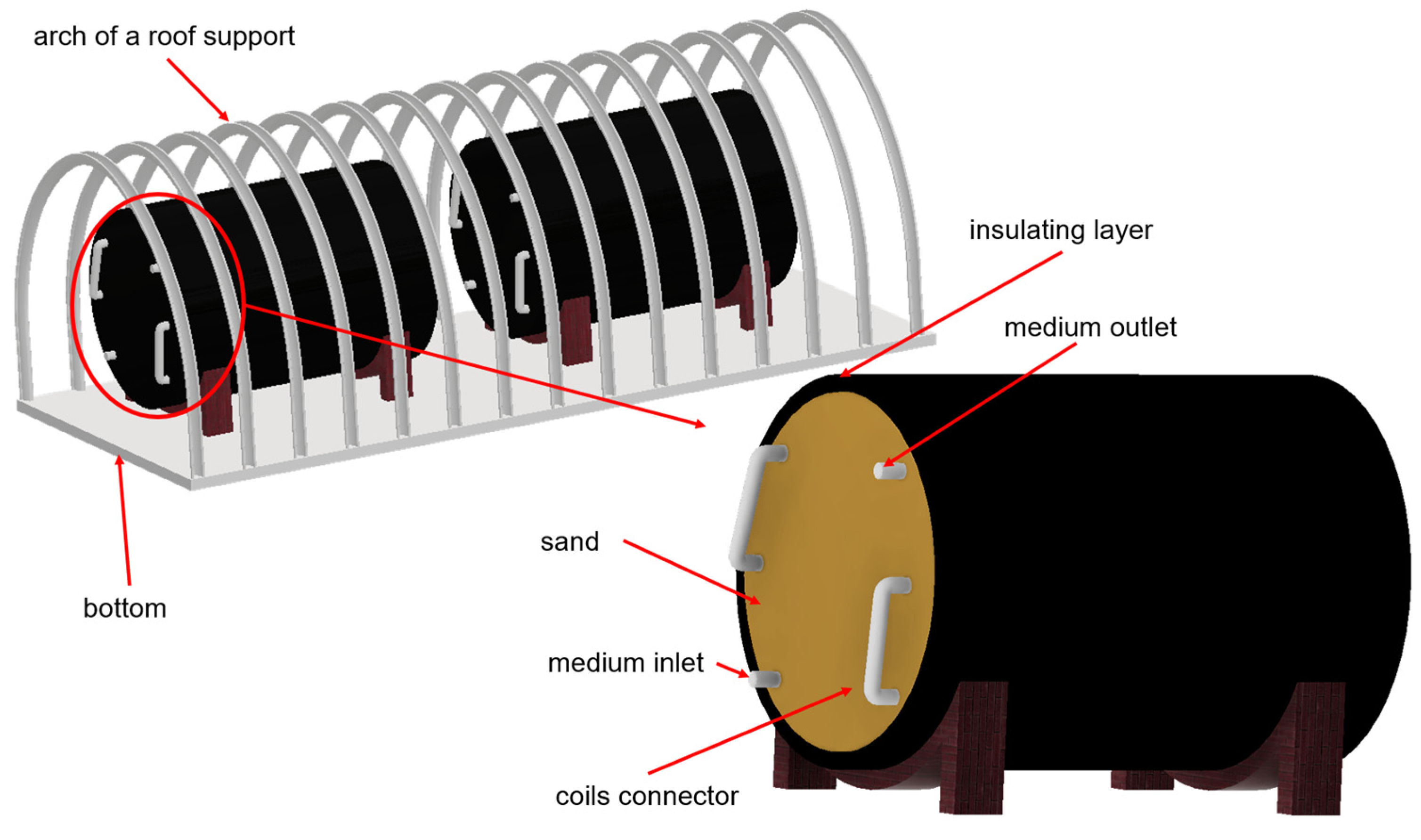
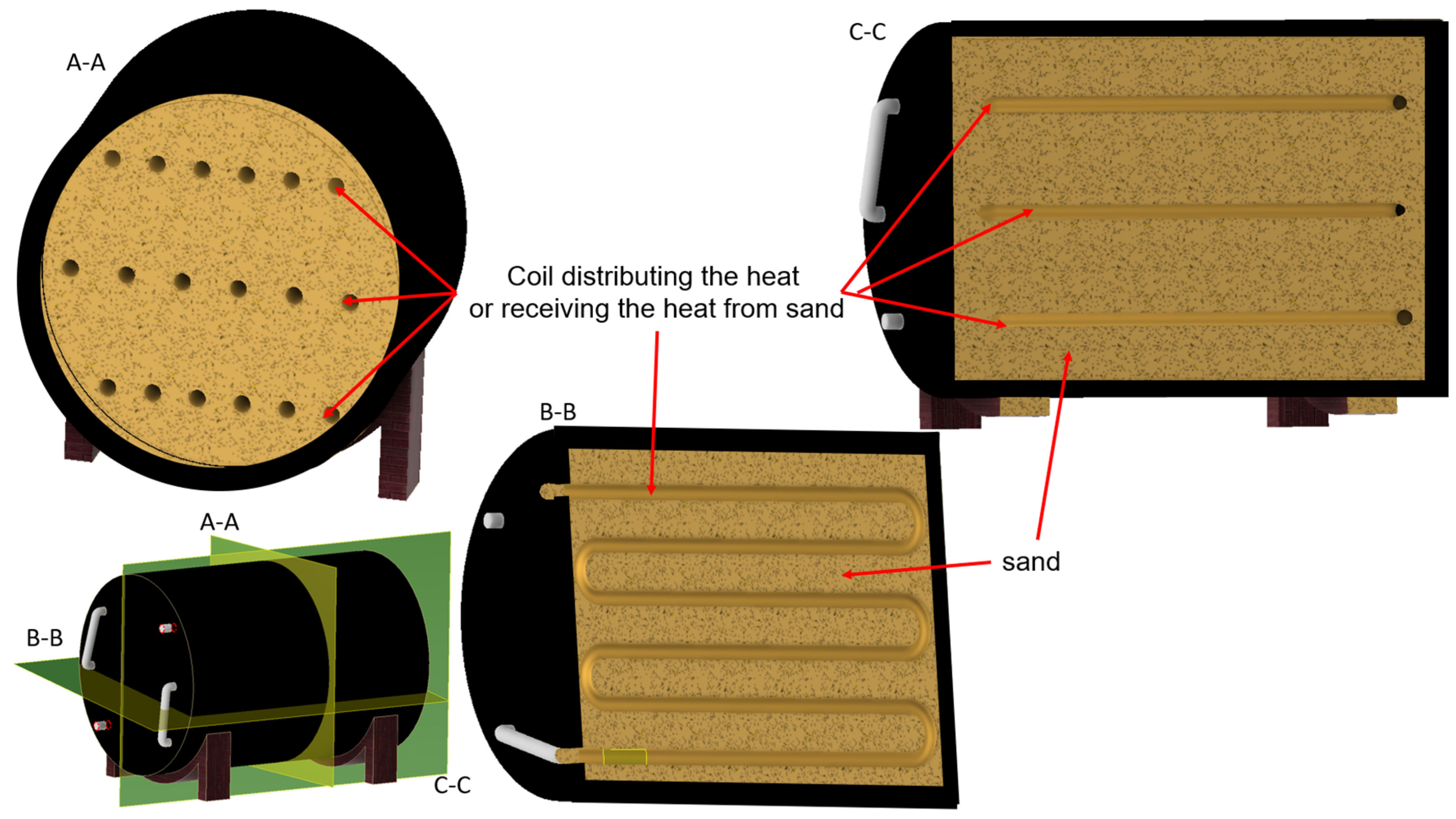
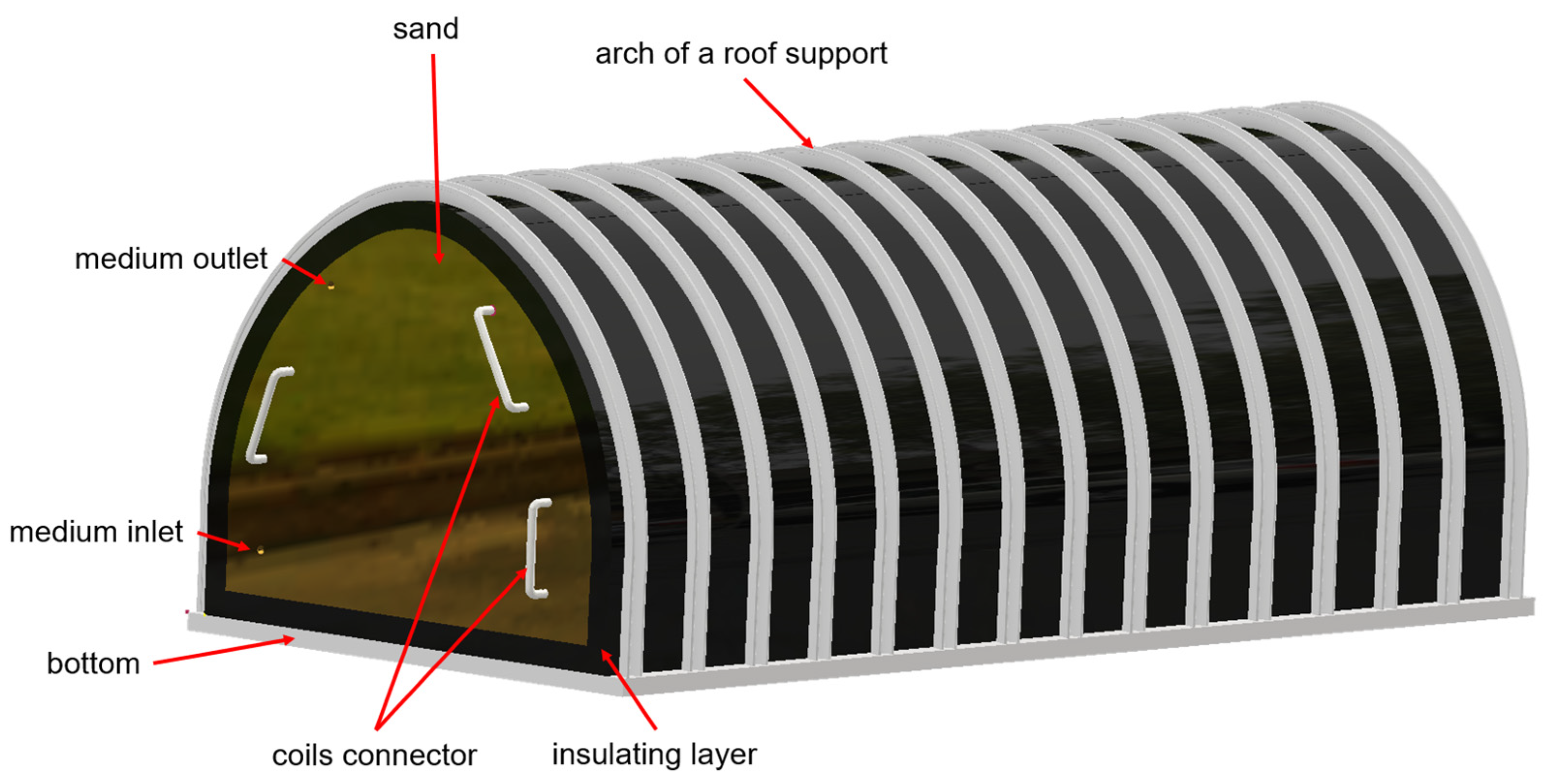
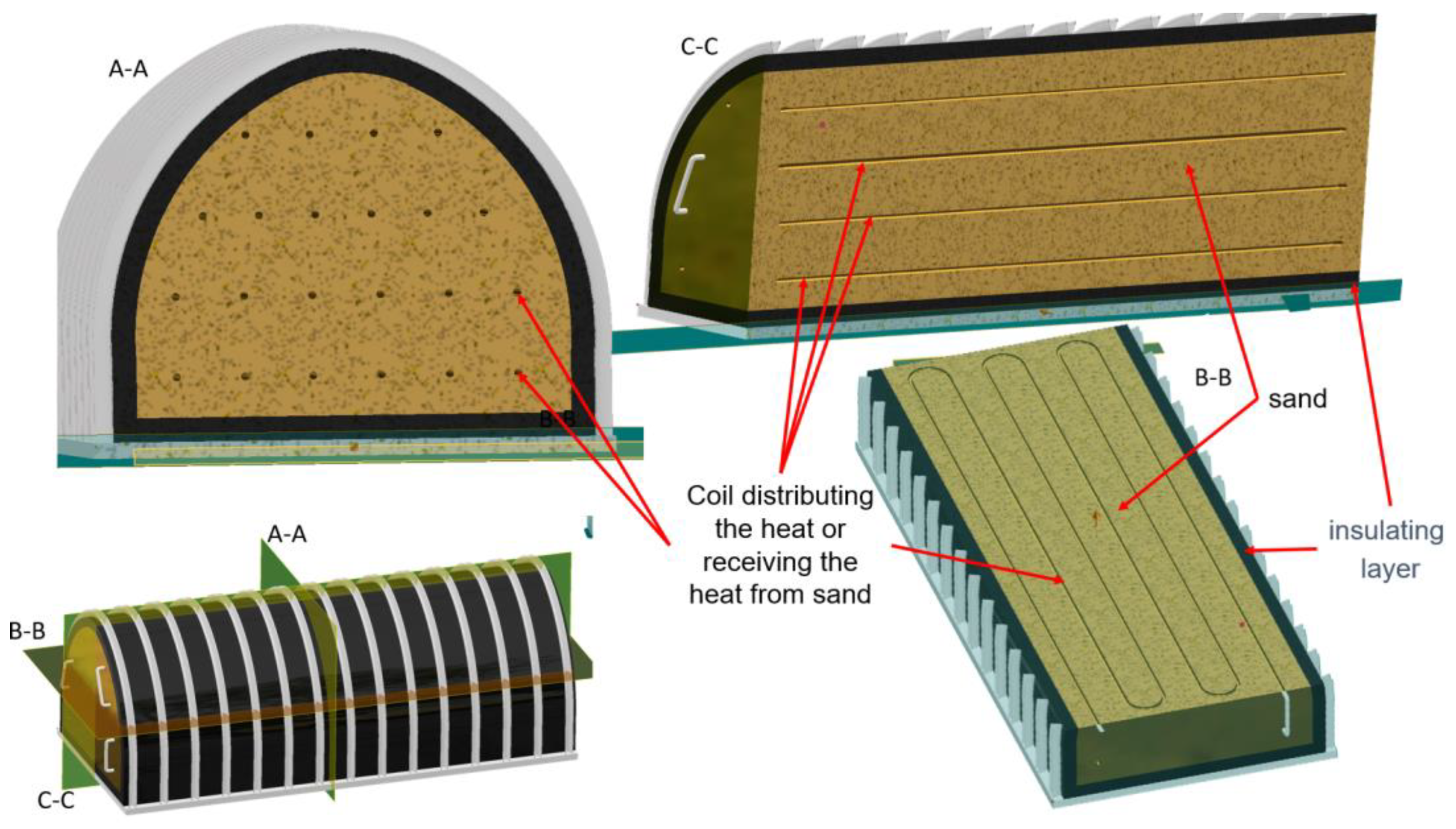
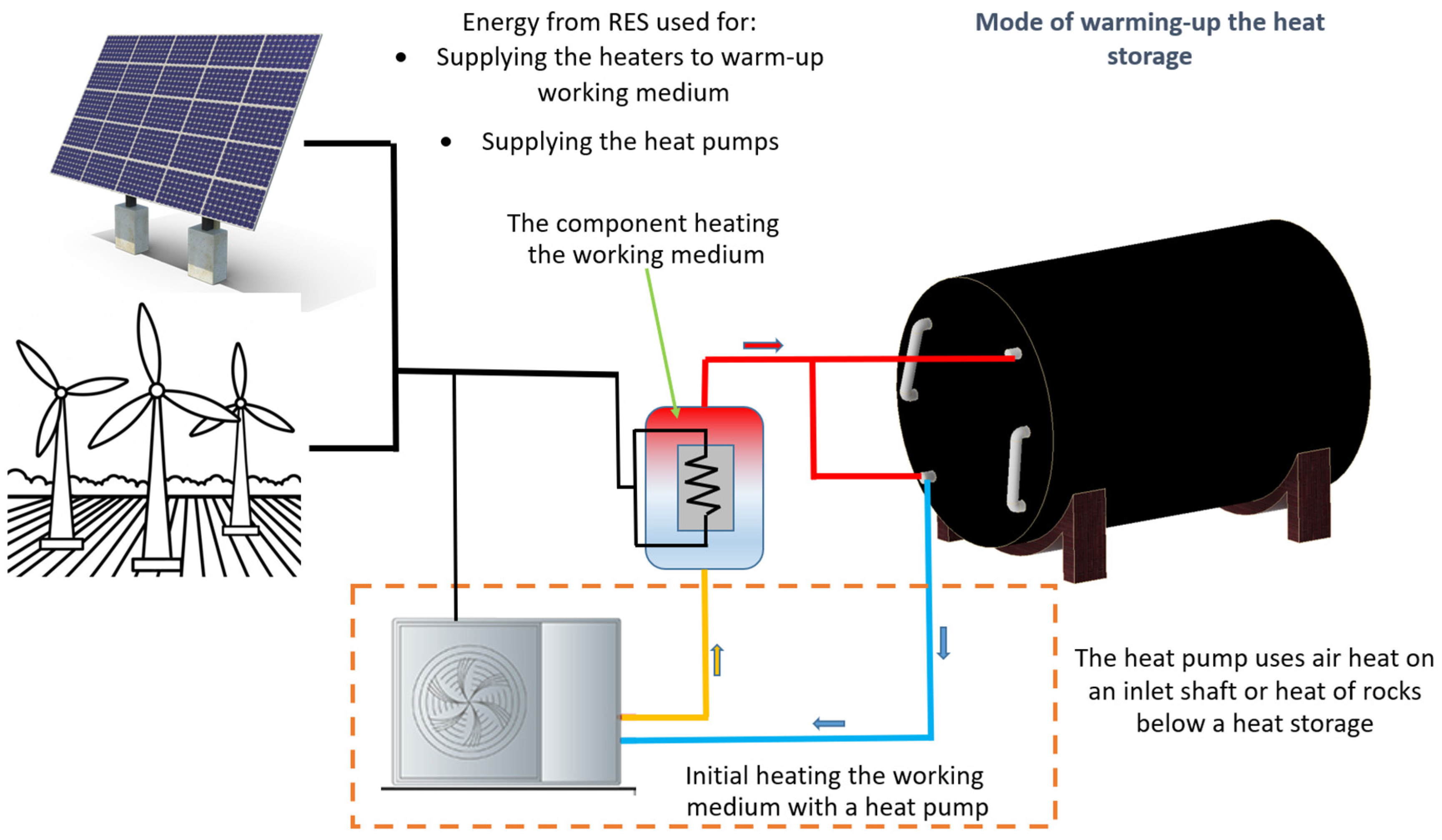
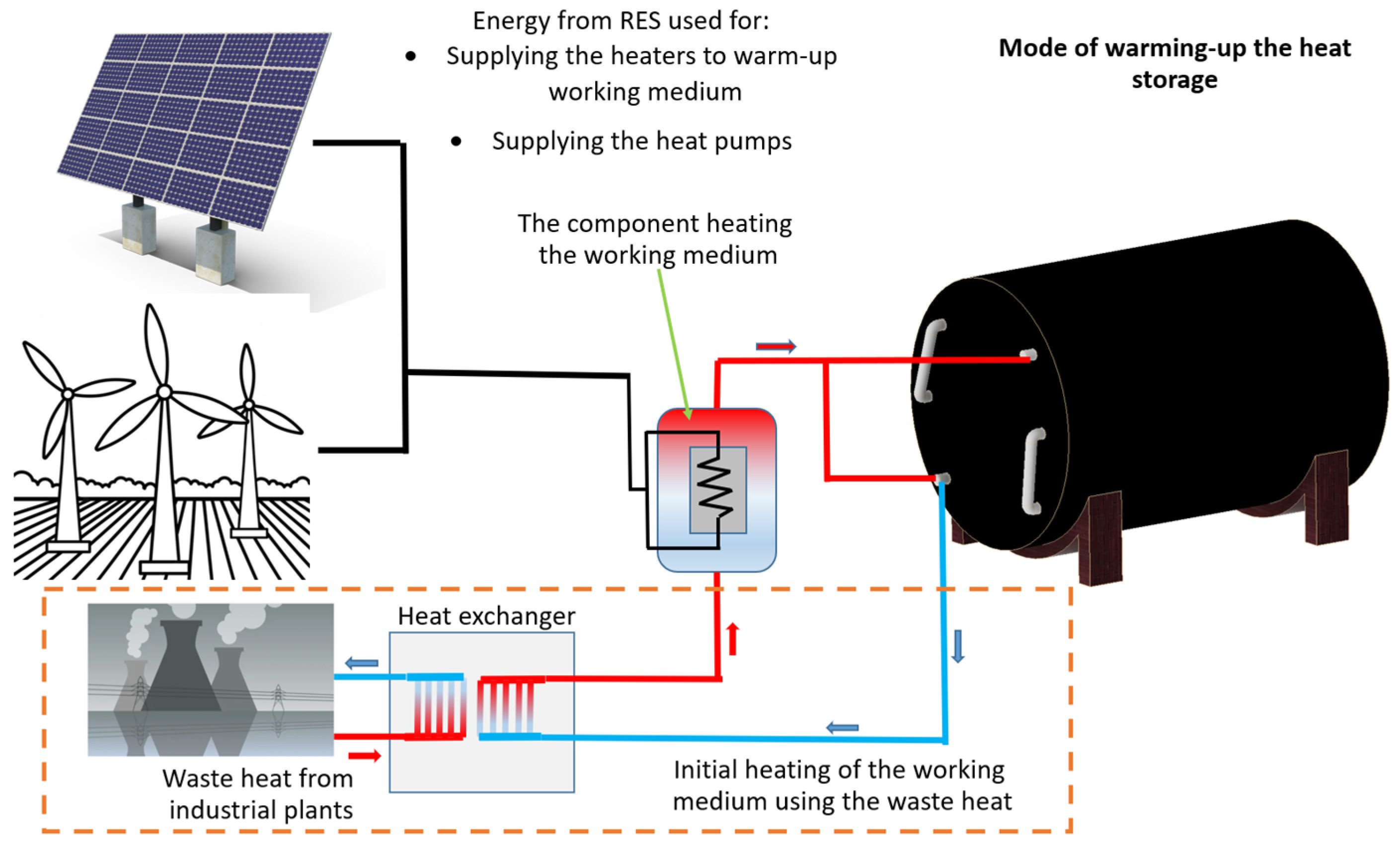

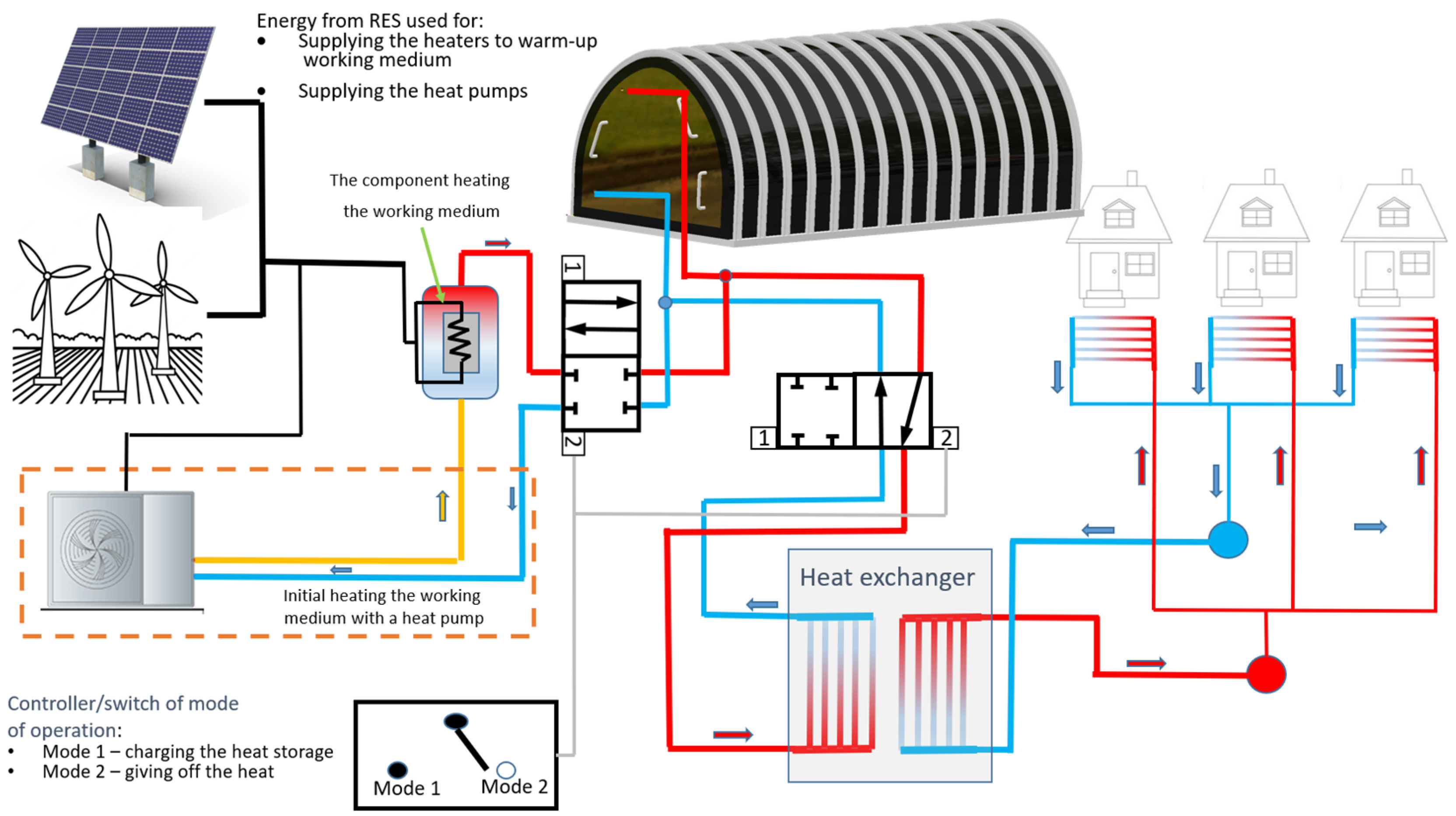
| Type of Material | Volume [m3] /Length [m] | Weight [kg] | Unit Price [PLN/Mg] | Cost [PLN] | |
|---|---|---|---|---|---|
| 1. | Insulation of glass granulate | 71.4 | 155 | 2600 | 403 |
| 2. | Washed sand | 98.2 | 177,000 | 25 | 4425 |
| 3. | Steel pipe Ø 63.5 × 5 mm–79 m | 79 | 570 | 31,000 | 17,670 |
| total | 22,498 |
| Type of Material | Volume [m3] /Length [m] | Weight [kg] | Unit Price [PLN/Mg] | Cost [PLN] | |
|---|---|---|---|---|---|
| 1. | Insulation of glass granulate | 1120 | 2441.6 | 2600 | 6348.16 |
| 2. | Washed sand | 1070 | 1,926,000 | 25 | 48,150 |
| 3. | Steel pipe Ø 63.5 × 5 mm–1100 m | 1100 | 7987 | 31,000 | 247,597 |
| total | 302,095.16 |
Disclaimer/Publisher’s Note: The statements, opinions and data contained in all publications are solely those of the individual author(s) and contributor(s) and not of MDPI and/or the editor(s). MDPI and/or the editor(s) disclaim responsibility for any injury to people or property resulting from any ideas, methods, instructions or products referred to in the content. |
© 2025 by the authors. Licensee MDPI, Basel, Switzerland. This article is an open access article distributed under the terms and conditions of the Creative Commons Attribution (CC BY) license (https://creativecommons.org/licenses/by/4.0/).
Share and Cite
Szewerda, K.; Michalak, D.; Matusiak, P.; Kowol, D. Concept of Adapting the Liquidated Underground Mine Workings into High-Temperature Sand Thermal Energy Storage. Appl. Sci. 2025, 15, 3868. https://doi.org/10.3390/app15073868
Szewerda K, Michalak D, Matusiak P, Kowol D. Concept of Adapting the Liquidated Underground Mine Workings into High-Temperature Sand Thermal Energy Storage. Applied Sciences. 2025; 15(7):3868. https://doi.org/10.3390/app15073868
Chicago/Turabian StyleSzewerda, Kamil, Dariusz Michalak, Piotr Matusiak, and Daniel Kowol. 2025. "Concept of Adapting the Liquidated Underground Mine Workings into High-Temperature Sand Thermal Energy Storage" Applied Sciences 15, no. 7: 3868. https://doi.org/10.3390/app15073868
APA StyleSzewerda, K., Michalak, D., Matusiak, P., & Kowol, D. (2025). Concept of Adapting the Liquidated Underground Mine Workings into High-Temperature Sand Thermal Energy Storage. Applied Sciences, 15(7), 3868. https://doi.org/10.3390/app15073868





